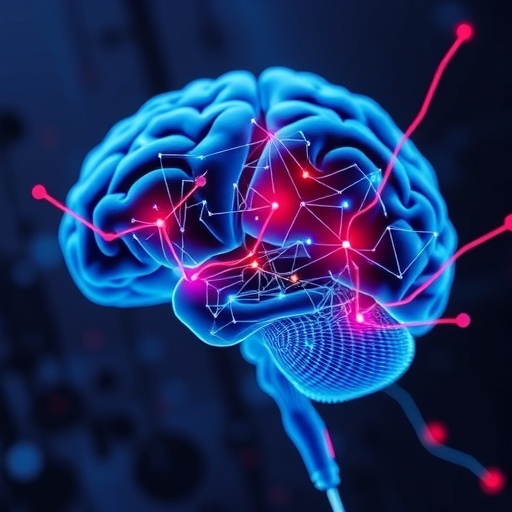In a groundbreaking study published in Nature Biomedical Engineering, researchers have unveiled a promising approach to understanding and decoding neural activity in patients with brain implants. This pioneering research, led by an international team of scientists, explores the interface between invasive neurophysiology and whole-brain connectomics to create a detailed mapping of brain activity. This mapping has the potential to revolutionize how we perceive and treat neurological disorders.
At the heart of this research lies the innovative use of neural implants, which have long been employed in medical settings to assist individuals with various conditions, such as epilepsy, Parkinson’s disease, and other neurodegenerative disorders. While these devices have proven beneficial in alleviating symptoms, the researchers have taken a significant step forward by harnessing the data generated from these implants to gain deeper insights into the workings of the human brain. This study emphasizes the importance of real-time data acquisition and analysis, which can ultimately lead to more effective therapies and treatments.
One of the key advancements presented in this study is the integration of invasive neurophysiology with advanced imaging techniques. Invasively acquired neural signals, collected through electrodes implanted in the brain, provide a unique window into the intricate neural codes that underlie brain functions. Coupled with whole-brain connectomics, which examines the relationships between different regions of the brain, this interdisciplinary approach offers a more holistic understanding of brain dynamics, akin to mapping a complex city’s roadways and traffic patterns.
The researchers implemented a sophisticated algorithm designed to decode neural signals in real-time. This algorithm analyzes the patterns of neuronal firing in response to stimuli, translating this information into actionable insights. By establishing a direct line between neural activity and cognitive output, the study sets the stage for using brain implants not merely as therapeutic devices but as tools for better understanding the fundamental mechanisms of thought, sensation, and movement.
Moreover, this research underscores the significance of connectomics—the study of the brain’s wiring and connections. The brain is an incredibly intricate network, and understanding how neurons communicate with one another is paramount for deciphering the mechanisms behind various cognitive functions and disorders. The study introduces a framework for analyzing how disconnection or altered connectivity patterns contribute to neurological conditions.
The implications of this research extend far beyond basic neuroscience. It opens new avenues for developing personalized medical interventions tailored to individual neural profiles. For patients with brain implants, the ability to decode and interpret their unique neural signals may lead to more efficient and targeted neurotherapies, potentially alleviating symptoms of their conditions more effectively than current one-size-fits-all approaches.
Additionally, the technology presented has significant implications for brain-computer interfaces (BCIs), which are designed to allow direct communication between the brain and external devices. By improving our understanding of how various regions of the brain interact, this research could enhance the design of BCIs, leading to more intuitive and effective control of assistive devices for patients suffering from severe motor disabilities.
The interdisciplinary nature of this research also highlights the importance of collaboration across multiple fields, including neuroscience, bioengineering, data science, and artificial intelligence. Researchers have emphasized that advances in one area can significantly impact another, and the convergence of these fields is essential for driving forward our understanding of brain function and the development of neural technologies.
Despite the promising nature of these findings, the research team is quick to acknowledge the challenges that remain. Ethical considerations regarding the use of invasive neurotechnologies must be addressed, particularly as we venture into an era where brain data may be interpreted and utilized in novel ways. The authors stress the need for strict guidelines to ensure that patient privacy and autonomy are preserved while maximizing the benefits of this technology.
This study not only helps to bridge the gap between theoretical knowledge and practical applications but also serves as a call to action for further research in this exhilarating field. As our understanding of the brain expands, so too does the potential for groundbreaking therapies that could improve the quality of life for countless individuals afflicted by neurological disorders.
In conclusion, the integration of invasive neurophysiology with whole-brain connectomics represents a significant leap forward in our quest to decode the complexities of the human brain. This research paves the way for innovative applications in clinical neuroscience, brain-machine interfaces, and personalized medicine. The road ahead may be fraught with challenges, but the insights gained from this study are poised to transform our understanding of the brain and its capacities.
As we stand on the precipice of a new era in neuroscience, the future of brain implants and neural decoding looks not only bright but also filled with possibilities. The journey to unravel the mysteries of the human brain continues, driven by cutting-edge research and unwavering curiosity.
Subject of Research: Invasive neurophysiology and whole-brain connectomics for neural decoding in patients with brain implants.
Article Title: Invasive neurophysiology and whole brain connectomics for neural decoding in patients with brain implants.
Article References:
Merk, T., Köhler, R.M., Brotons, T.M. et al. Invasive neurophysiology and whole brain connectomics for neural decoding in patients with brain implants.
Nat. Biomed. Eng (2025). https://doi.org/10.1038/s41551-025-01467-9
Image Credits: AI Generated
DOI: 10.1038/s41551-025-01467-9
Keywords: neural decoding, brain implants, neurophysiology, connectomics, brain-computer interface, neurological disorders.




